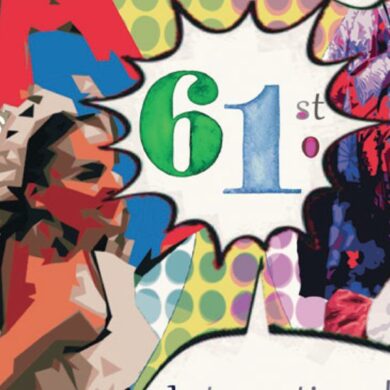At Atomix, a set of colorful cards gives diners insight into Korean culture and a piece of the restaurant to take home
A small brushed-metal tin of shortbread cookies. A humble jar of granola. A dark bottle of rich balsamic vinegar. These are among the gifts that the world’s top fine dining restaurants give to guests at the conclusion of a meal. This year, a new tasting-menu restaurant joined that list with a takeaway that begs not to be eaten but admired under a pane of glass.
It’s a set of 10 notecards, with delicate, colorful, minimalist abstractions of each course on the front, and on the reverse, a list of the ingredients the dish comprises as well as brief remarks on its context, whether personal, cultural, or historical. Each card is presented before the course is served, a teaser for the imminent plate, leaving guests wondering how these jaunty lines, circles, and squiggles will assemble into yet another dish inspired by Korean ingredients and techniques. At the end of the tasting menu, the cards are boxed up for guests to take home, a memento of a meal that also offers a primer on Korean culture and design.
:no_upscale()/cdn.vox-cdn.com/uploads/chorus_asset/file/13662646/AtomixSpots_3.jpg)
Atomix, the acclaimed Korean restaurant that opened in New York City in May and was awarded a Michelin star last month, takes the aesthetic harmony that’s de rigueur in fine dining restaurants and amplifies it in delightfully surprising ways — and with a distinctively Korean touch. Here, husband-and-wife duo JungHyun “JP” Park and JeongEun “Ellia” Park have created a refined space infused with considered contemporary Korean design details. The striking bilevel space, custom uniforms, handmade tableware, one-of-a-kind chopsticks, and menu cards-cum-design objets were all crafted by a cadre of Korean designers, whose work the Parks are eager to introduce to guests. Taken together, these elements instill the meal with a thoughtfulness and quiet intimacy, firmly placing the food on par with art and spotlighting lesser-known aspects of Korean culture, with design foremost among them.
“Cooking is also a kind of art, and the chef is another artist,” Ellia Park, who oversees the restaurant’s front of house, says. “The restaurant is not only about the food. It’s the experience for the guests, it’s the whole, the space — how the colors will be, or the table texture or the chairs, or what the staff wears.”
The result is a veritable feast for design heads. Chris Lee, a Brooklyn artist who collaborated with the Parks on the next season of menu cards, recalls his visit to Atomix: “You’re just downloading all the things they presented to you because everything is really considered. You’re using all your senses and so sometimes you can get super overwhelmed. [It’s like] after you go to the Guggenheim or MoMA, after that walking around and [you feel] like your head’s about to explode.”
:no_upscale()/cdn.vox-cdn.com/uploads/chorus_asset/file/13662642/AtomixSpots_1.jpg)
Atomix is situated in an unassuming apartment building on East 30th Street. The Parks searched for residential buildings to house a restaurant they envisioned as creating an experience more akin to dinner at a friend’s house. “We always thought about it like a hidden restaurant — not open like a fine dining restaurant but more like a home, like an invitation from [another] person,” Ellia Park says of the design, created with the help of Seoul architecture firm Studio Writers. “When you open the door it’s kind of another world.”
Guests step through the front door into a dark entry room with a single hanging light before entering a cozy bar area. They descend the stark, monochrome stairway, which reveals a light-filled, double-height lounge area. Finally the dark-marble chef’s counter comes into view, with low ceilings and dramatic spotlights depositing guests back to a comforting atmosphere. Warm, neutral colors swathe the entire space, accompanied by natural materials like wood and stone.
Once guests are seated at the U-shaped counter, servers in gray smocks (created by Korean-born New York menswear designer Sungho Ahn, a good friend of the Parks) place the first menu card before each of the 14 diners; the play begins.
The menu cards serve two vital functions. The first is posterity. “We love fine dining restaurants, but it’s really hard to memorize everything,” Ellia Park admits. With the cards, “I hope all the guests can remember our experience.” The second is tangibility. “If you hang your art on the wall, you can see it all the time, or if you make music, you can listen all the time. But for food, if you make it, you eat it and it just disappears.” Indeed, many guests frame and hang the cards, and send her pictures. “It really makes me so happy and so proud,” she says.
For the first two seasons’ menu cards, chef JP Park sent Seoul designer Youme Oh detailed notes and rough sketches of each dish as he intended it to look on the plate. Since Oh (who happens to be the chef’s cousin) never visited the restaurant, she began to see the menu cards as a way to learn more about the food, almost literally as a student would. “I was thinking about the flashcards when you learn vocabulary or some new language because I’m not an expert on this food or this cooking,” she says. “The menus JP gave me were like a new language.”
Oh figured that guests to Atomix would be new to Korean gastronomy, or least this interpretation of it, and so the idea of a kind of “flashcards to Korean cuisine” was born. They started as realistic illustrations of the dishes, until Oh realized that a simple, abstract graphic was less redundant (diners can take photos of the food anyway) and better suited to projecting guests’ personal reactions to and memories of the dishes.
This past fall, the first course of guk, or soup, was presented alongside a card showing red and white squiggles dancing around three yellow dots orbiting three larger green circles on a green gradient background. The green background, Oh explains, represents the green of the tomatoes in the soup as well as fading summer, while the three circles in the center symbolized the scallops, the yellow dots pickled elderberry, and the wavy lines the tomato broth.
The ceramics for each course were handcrafted by designers in Korea (duly credited on each menu card); many were tailored specifically to the dish they hold. “JP Park told me he wanted a bowl for guk but he didn’t know what was going to be in that bowl yet,” says Oh, who designed bowls and a plate in addition to the menu cards. The chef was a fan of her previous series of odd, uneven ceramics, and asked for similar pieces that were rough, dark, and had a neutral glaze — a clear departure from traditional Korean ceramics, which tend to be, as Oh says, “very even and clear edges and white.”
Along with the names of ceramic artists, each card provides context for the course, with JP Park occasionally drawing upon his own history for the text. “His life is always connected to food,” Ellia Park says, adding that sometimes even she is surprised by what he comes up with. The notes have gotten much more personal since the opening and are now scattered with first-person observations: how a Korean TV show inspired one dish, for example, as well as how the chef fostered a love of gim, or dry-roasted seaweed, since childhood.
These anecdotes offer real points of connection, which was important to the Parks, who arrived in the country six years ago without knowing a soul and with no intention of staying longterm. All the design details at Atomix are in the service of connecting with guests and sharing Korean culture in a friendly, accessible way. This includes the moment after the first course when Ellia Park presents diners with a tray of chopsticks, each pair sourced over years from Korean artists and craftspeople. The gesture, inspired by steakhouses where you choose your own steak knife and Japanese restaurants where you select a sake cup, signals that Atomix is not just any fine dining restaurant, but also a cultural place.
What makes these touches all the more impressive is that the couple has no formal background in design (neither went to culinary school either). “We just love design — fashion design, interior design, we love all the elements of design,” Ellia says, noting that all aesthetic decisions are made together. Design was something they had in mind when they opened their first restaurant Atoboy, also in New York, but honed in on with Atomix. “Atoboy’s a more hip place, more fun and easygoing,” Ellia says. “I was looking for a funky style for Atoboy, more like street fashion, like Supreme.” (She does not rule out a possible fashion line in the future.) Atomix’s vibe, on the other hand, is delicate, balanced, and upscale. “We were really careful about all the design here, and we chose every single piece.”
:no_upscale()/cdn.vox-cdn.com/uploads/chorus_asset/file/13662645/AtomixSpots_2.jpg)
Ellia Park believes Korean fare has been unjustly underrated, especially compared to Japanese food. “People would pay hundreds of dollars for sushi at a Japanese restaurant, but when they think about Korean cuisine, they don’t want to spend more than $50,” she says, noting that guests complained about the $39 prix fixe menu at Atoboy its first season. “To non-Korean people, Korean food is always barbecue or something spicy or bibimbap, but we want to show guests the variety of Korean cuisine. We want to change the way people think of Korean cuisine in the States and in the world.” To that end, Ato is the Old Korean word for gift.
“What’s cool about [the Parks],” says Lee, “is they’re focused on finding Korean and Korean-American people to work with and really celebrating the heritage.” Lee, a relative newcomer to design who has done branding for the modern Vietnamese restaurant Di An Di and Malaysian cafe Parlay, both in Brooklyn, said working with fellow Korean creatives allowed him to “advocate for something I really believe in. It was really important to me to work with Korean people and be taken under their wing.”
Atomix is predominantly filled with Korean design, but not exclusively: A light by the German designer Ingo Maurer hangs at the entrance, and hot local studio Apparatuscreated the lighting. Ellia Park cites Fäviken, Noma, and Single Thread as restaurants that have impressed her with their design overall. “Of course when I go to a restaurant, I check the menu, the check plate, the uniform — all the details are really important,” she says. “But I get the big impression of the design from the whole space and how it goes with everything.”
Ellia Park now warns all her chef friends who want to open restaurants not to overlook the details, especially those beyond the dining room. “My most important thing in any restaurant is the bathroom,” she says. “It has to be always be clean but also warm and cozy. If they’re careful about even the restroom, I can maybe trust them on other things.”




